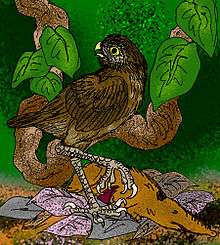Ornimegalonyx
The Cuban giant owl or giant cursorial owl (Ornimegalonyx) is an extinct genus of giant owl that measured 1.1 metres (3 ft 7 in) in height. It is closely related to the many species of living owls of the genus Strix.[2] It was a flightless or nearly flightless bird and it is believed to be the largest owl that ever existed. It lived on the island of Cuba.
| Cuban giant owl Temporal range: Late Pleistocene | |
|---|---|
 | |
| Scientific classification | |
| Kingdom: | Animalia |
| Phylum: | Chordata |
| Class: | Aves |
| Order: | Strigiformes |
| Family: | Strigidae |
| Genus: | †Ornimegalonyx Arredondo, 1954 |
| Species | |
The first fossil specimen was mistakenly described as a bird in the family Phorusrhacidae, in part because the bones were so large. In 1961, Pierce Brodkorb reviewed the findings and placed them properly, with the owls. Remains have been abundant throughout the island, in cave deposits from the Late Pleistocene period (126,000 to 11,700 years ago) and at least three nearly complete skeletons have been found.
"Ornimegalonyx arredondoi" is a nomen nudum; the name was proposed for this species before it was described but oteroi was eventually adopted by Oscar Arredondo (according to the rules of the ICZN, naming a species after oneself is not prohibited, but it is frowned upon as vain by the scientific community).
Description
Arredondo estimated the height of Ornimegalonyx to have been 1.1 metres (3 ft 7 in) tall and it probably easily exceeded 9 kilograms (20 lb).[3] It had very long legs for its size, but was bulky overall and probably short-tailed. The modern owl that most resembles the Cuban giant owl in proportions is probably the dainty burrowing owl, the only surviving owl closely tied to the ground. This implies similar adaptations to the terrestrial lifestyle, but not a close phylogenetic relationship.
The legs and feet of the Cuban giant owl appear to be very large and powerfully built. This supports the theory that they were strong runners, hence the alternate name, cursorial. The keel of the sternum was reduced and the owl may have been capable of short burst of flight. It is probable that, like a modern wild turkey, the owl only took flight when extremely pressed, more often choosing to run.
Diet
The Cuban giant owl is believed to have preyed principally on large rodents including Heteropsomys, Capromys, Geocapromys, and Macrocapromys (the size of modern nutria or capybara) and the ground sloths Cubanocnus, Miocnus, Mesocnus, and Megalocnus.[3] It was probably an ambush predator that would pounce on unsuspecting prey with its crushing talons.
See also
- Tyto pollens
- Grallistrix
- Chickcharney
- Late Quaternary prehistoric birds
- List of extinct birds
- List of fossil birds
- List of extinct animals
- Flightless birds
References
- Arredondo, Oscar (1982). Los Strigiformes fósiles del pleistoceno cubano. Boletín de la Sociedad Venezolana de Ciencias Naturales 140, 33-55.
- Feduccia, Alan (1996) "The Origin and Evolution of Birds" Yale University Press
- Arredondo, Oscar (1976) translated Olson, Storrs L. "The Great Predatory Birds of the Pleistocene of Cuba" pp. 169-187 in "Smithsonian Contributions to Paleobiology number 27; Collected Papers in Avian Paleontology Honoring the 90th Birthday of Alexander Wetmore"